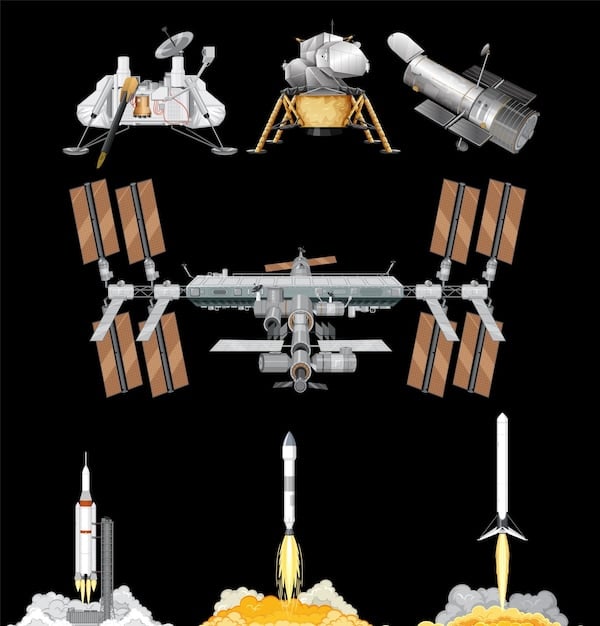The US Space Program: Future Exploration & National Security

The US space program stands at a crucial juncture, propelling humanity towards ambitious new frontiers in exploring the cosmos while simultaneously bolstering national security through advanced satellite capabilities and strategic space dominance.
The vast expanse of space continues to captivate humanity, inspiring innovation that pushes the boundaries of what is possible. For the United States, The US Space Program: Exploring the Future of Space Exploration and National Security is not merely an academic pursuit but a strategic imperative, driving scientific discovery, economic growth, and safeguarding national interests in an increasingly complex geopolitical landscape.
The Enduring Legacy of American Space Exploration
The United States has long been at the forefront of space exploration, a journey marked by iconic milestones and relentless innovation. From the thrilling Space Race era to the establishment of the International Space Station, American ingenuity has consistently pushed the boundaries of human endeavor beyond Earth’s atmosphere. This legacy is built on a foundation of scientific inquiry, engineering prowess, and a profound curiosity about the universe.
The early years of the US space program were defined by competition and a fervent drive to be the first. This ambition culminated in monumental achievements like the Apollo missions, which not only landed humans on the Moon but also galvanized a nation and inspired generations to pursue careers in STEM fields. These missions were complex undertakings, requiring unprecedented levels of coordination and technological development.
Pioneering Missions and Scientific Breakthroughs
Beyond the Moon, NASA’s robotic explorers have ventured across the solar system, providing invaluable data and stunning images. Missions like the Voyager probes have traveled to the outer reaches of our solar system and beyond, continuing to transmit data decades after their launch. These long-duration missions underscore the durability and foresight of American space engineering.
- Mars Rovers: Spirit, Opportunity, Curiosity, and Perseverance have revolutionized our understanding of the Red Planet’s geological history and potential for past life.
- Hubble Space Telescope: Provided breathtaking images and critical data, expanding our knowledge of galaxies, stars, and the universe’s expansion.
- Kepler Space Telescope: Discovered thousands of exoplanets, radically changing our perception of planetary systems beyond our own.
- New Horizons: Completed the first-ever close flyby of Pluto, revealing a surprisingly complex and geologically active world.
These missions, along with countless others, have not only expanded scientific knowledge but also demonstrated the remarkable capabilities of American scientists and engineers. The data collected from these ventures informs future missions and helps us better understand our place in the cosmos.
The pursuit of scientific understanding is a core tenet of the US space program, fostering international collaboration while maintaining a competitive edge. This balance ensures that the benefits of space exploration extend globally, while American leadership in critical technologies remains unchallenged. The ongoing commitment to scientific discovery reflects a deeply ingrained desire to answer the fundamental questions about life and the universe.
Artemis: The Return to the Moon and Beyond
The Artemis program represents a bold new chapter for the US space program, aiming to return humans to the Moon and establish a long-term presence there. This initiative is not merely a nostalgic revisit to past glories but a strategic stepping stone for future crewed missions to Mars and beyond. It signifies a renewed commitment to deep space exploration, with a focus on sustainable lunar operations.
The program’s ambitious goals include landing the first woman and first person of color on the Moon. This commitment to diversity and inclusion reflects modern values and seeks to inspire a broader range of individuals to engage with space exploration. The technological challenges are immense, from developing powerful new rockets like the Space Launch System (SLS) to crafting habitats and systems that can sustain human life on the lunar surface.
Establishing a Lunar Gateway and Orbital Infrastructure
A key component of the Artemis program is the development of the Gateway, a small space station orbiting the Moon. This outpost will serve as a temporary living and working space for astronauts, as well as a staging point for missions to the lunar surface and potentially deeper into space. The Gateway concept offers significant flexibility and research opportunities that were not available during the Apollo era.
- Gateway’s Purpose: Facilitate access to the lunar surface, serve as a science platform, and test technologies for future deep-space missions.
- International Collaboration: NASA is partnering with international agencies and private companies, leveraging global expertise and resources.
- Lunar Surface Operations: Focus on understanding lunar resources, particularly water ice at the poles, which could be vital for future long-duration missions.
The infrastructure being developed for Artemis will provide a robust framework for sustained human presence beyond Earth orbit. This includes advanced life support systems, power generation, and communication technologies that can operate effectively in the harsh lunar environment. The lessons learned from establishing and maintaining lunar assets will be critical for eventual missions to Mars.

The path to Mars is long and fraught with challenges, but the Artemis program is designed to systematically address these by first building a presence on the Moon. The Moon will act as a proving ground, allowing engineers and scientists to refine technologies and procedures in a real-world, off-Earth environment. This methodical approach aims to mitigate risks and increase the probability of success for future interplanetary travel.
Commercialization and Innovation in Space
The landscape of space exploration is rapidly transforming, largely due to the increasing involvement of private companies. This commercialization wave is injecting unprecedented levels of innovation, competition, and efficiency into the space industry, driving down costs and accelerating development timelines. Companies like SpaceX, Blue Origin, and United Launch Alliance are leading this charge, developing new launch vehicles, spacecraft, and satellite technologies.
This shift from government-led initiatives to a more diverse ecosystem of public-private partnerships represents a fundamental change in how space is accessed and utilized. NASA, once almost the sole entity in American space endeavors, is now becoming a key customer and facilitator, fostering private sector growth while focusing its efforts on high-risk, high-reward research and exploration that only a government agency can undertake.
The Rise of Private Space Companies
The emergence of commercial space companies has democratized access to space, making it more affordable and frequent. Reusable rocket technology, pioneered by companies like SpaceX, has drastically reduced launch costs, opening up new possibilities for satellite deployment, space tourism, and even interplanetary travel. This economic shift creates new industries and jobs, further boosting the US economy.
- Reusable Rockets: Falcon 9 and Starship capabilities have transformed launch economics, making orbital access more accessible.
- Satellite Constellations: Companies are deploying massive networks like Starlink to provide global internet access, creating new markets and services.
- Space Tourism: Ventures like Virgin Galactic and Blue Origin are making suborbital and orbital flights accessible to private citizens.
The private sector’s agility and focus on efficiency complement traditional government programs, allowing for faster development cycles and more experimental approaches. This synergistic relationship benefits both parties, enabling NASA to pursue its ambitious exploration goals while private companies innovate and expand commercial opportunities in space. The rapid pace of technological advancement in the commercial sector is truly remarkable, reflecting a new golden age of space development.
This evolving ecosystem means that the US space program is no longer solely reliant on direct government funding for all its objectives. Commercial capabilities can support NASA’s needs, freeing up taxpayer money for fundamental research and groundbreaking missions that otherwise might not be feasible. This model promises a more robust and sustainable future for American space endeavors, fostering a dynamic environment where innovation thrives.
Space and National Security: A Crucial Nexus
The intersection of space exploration and national security has never been more critical. As humanity’s reliance on space-based assets grows, so too does the imperative to protect these vital systems. Satellites are indispensable for modern navigation, communication, weather forecasting, intelligence gathering, and military operations. Ensuring their resilience and denying adversaries the ability to disrupt them is a paramount concern for US national security.
The establishment of the US Space Force in 2019 underscored the strategic importance of space as a warfighting domain. This new branch of the military focuses exclusively on organizing, training, and equipping space forces to protect US and allied interests in space, deter aggression, and, if necessary, operate in, from, and to space to conduct military operations. It reflects a clear recognition that space is no longer just a peaceful frontier, but a contested domain.
Protecting Critical Space Assets
The vulnerability of space assets to anti-satellite (ASAT) weapons, cyberattacks, and orbital debris poses significant threats. Nations like China and Russia are developing sophisticated capabilities to deny, disrupt, or destroy satellites, making effective space situational awareness and defensive measures absolutely essential. The ability to monitor objects in orbit and predict potential collisions or hostile acts is a cornerstone of space security.
- Space Situational Awareness (SSA): Tracking thousands of objects in orbit to identify threats and maintain a comprehensive picture of the space environment.
- Satellite Resilience: Designing satellites with redundancies, maneuverability, and cyber defenses to withstand attacks and operate in contested conditions.
- Deterrence: Developing countermeasures and demonstrating a credible capability to respond to aggression in space.
Investment in advanced space technologies, including next-generation intelligence, surveillance, and reconnaissance (ISR) satellites, is vital for maintaining strategic advantage. These capabilities provide real-time data that informs decision-making for both military and humanitarian operations worldwide. The ability to monitor global events from space provides an unparalleled perspective, enhancing national security significantly.

Beyond defensive measures, offensive capabilities in space, while controversial, are also part of national security considerations. The goal is to deter potential adversaries from interfering with American and allied space systems by demonstrating that such actions would incur unacceptable costs. This complex balance of defense and deterrence underpins modern space strategy, ensuring peace through strength and readiness.
The Economic Impact of Space Endeavors
The US space program is a significant engine of economic growth, generating jobs, fostering innovation, and driving technological spill-overs across various sectors. The investment in space-related activities creates a ripple effect throughout the economy, from manufacturing and advanced materials to software development and data analytics. This economic impact extends far beyond the direct funding of NASA or defense programs.
The burgeoning commercial space industry alone represents a multi-billion-dollar enterprise, attracting substantial private investment and venture capital. New companies are constantly emerging, offering services ranging from launch provision and satellite manufacturing to orbital debris removal and in-space servicing. This commercial dynamism contributes to the nation’s GDP and strengthens America’s competitive position in the global economy.
Job Creation and Technological Spin-offs
The space sector supports a highly skilled workforce, including engineers, scientists, technicians, and project managers. These high-paying jobs contribute to local economies and attract talent. Furthermore, technologies developed for space often find unexpected applications on Earth, leading to new products and services that improve daily life. These “spin-offs” are a well-documented benefit of space research.
- Medical Devices: Miniaturized sensors and imaging technology developed for space exploration have led to advancements in medical diagnostics.
- Consumer Electronics: Innovations in battery technology, solar cells, and advanced materials originally for spacecraft are now common in everyday products.
- GPS and Communications: Satellite navigation and communication systems are fundamental to global commerce, logistics, and personal devices.
The indirect economic benefits are substantial, as industries leverage space-derived data for agriculture, urban planning, disaster response, and climate monitoring. Earth observation satellites, for example, provide critical information for optimizing crop yields, managing natural resources, and tracking environmental changes. This data-driven approach enhances productivity and sustainability across diverse sectors.
Investment in space also stimulates research and development, maintaining America’s leadership in scientific and technological fields. The challenges of space exploration demand groundbreaking solutions, which often lead to patents, intellectual property, and new capabilities that can be commercialized. This virtuous cycle of innovation and economic return ensures that the US maintains its edge in the global technology race, providing a strong foundation for future prosperity.
International Collaboration and Global Leadership
The US space program has a long tradition of international cooperation, recognizing that the challenges and opportunities of space exploration are often best addressed through shared effort. Collaborations with agencies like the European Space Agency (ESA), Japan Aerospace Exploration Agency (JAXA), and the Canadian Space Agency (CSA) have led to monumental achievements, most notably the International Space Station (ISS).
This collaborative approach not only pools resources and expertise but also fosters diplomatic ties and promotes peaceful uses of outer space. In an era of global challenges, space provides a unique platform for nations to work together towards common scientific and exploratory goals, transcending political differences. The ISS stands as a testament to what can be achieved when nations unite for a shared vision.
Strategic Partnerships for Future Missions
As the US embarks on new ambitious endeavors like the Artemis program, international partnerships remain a cornerstone of its strategy. Several nations have already committed to supporting the Artemis missions, contributing modules for the Gateway, lunar landers, and scientific instruments. This global participation enhances the program’s capabilities and provides broader international buy-in for future lunar and Martian exploration.
- ISS Operations: Ongoing cooperation ensures continued scientific research and human presence in low Earth orbit.
- Artemis Accords: A set of non-binding principles for responsible space exploration, promoting transparency, safety, and peaceful uses of space.
- Data Sharing: Collaborative scientific missions often involve sharing data and research findings, accelerating global scientific progress.
These partnerships extend beyond government agencies to include participation from international commercial entities, creating a multi-faceted approach to space exploration and utilization. The shared investment reduces the financial burden on any single nation and leverages specialized expertise from various countries. This distributed model of cooperation is becoming increasingly important for complex future missions.
By leading through collaboration, the United States reinforces its position as a global leader in space, inspiring other nations and setting norms for responsible behavior in orbit. This soft power aspect of space cooperation is as important as the technological advancements themselves, contributing to a stable and cooperative international environment. The vision for future space exploration is inherently global, recognizing that the cosmos belongs to all humanity.
| Key Aspect | Brief Description |
|---|---|
| 🚀 Space Exploration | Drives scientific discovery, human missions (Artemis to Moon/Mars), and understanding of the cosmos. |
| 🛡️ National Security | Protects vital satellite assets, ensures space dominance, and deters aggression in a contested domain. |
| 💰 Economic Impact | Creates jobs, fosters innovation, and generates technological spill-offs benefiting diverse Earth-based industries. |
| 🤝 Global Leadership | Promotes international collaboration, sets norms for responsible use of space, and reinforces U.S. influence. |
Frequently Asked Questions About the US Space Program
The primary goal of the Artemis program is to return humans to the Moon, including the first woman and person of color, and establish a long-term presence there. This lunar base will serve as a crucial stepping stone for future human missions to Mars, allowing for the testing of technologies and procedures in a demanding space environment before attempting a more distant journey.
The US space program significantly enhances national security by providing critical satellite capabilities for communication, navigation, intelligence gathering, and military operations. It involves monitoring space for threats, developing resilient space assets, and maintaining deterrence against potential adversaries who might seek to disrupt or attack US space systems, ensuring strategic advantage and global stability.
Private companies play an increasingly vital role, driving innovation and efficiency in the space sector. They develop reusable rockets, operate massive satellite constellations for global internet, and are pioneering space tourism. This commercialization reduces launch costs, accelerates development timelines, and allows government agencies like NASA to focus on deep-space exploration and fundamental research.
Space spin-offs are technologies developed for space exploration that find unexpected applications here on Earth. These include advancements in medical imaging, battery technology, fire-resistant materials, and GPS. They are important because they demonstrate a significant return on investment for space programs, improving daily life, boosting economic growth, and often creating entirely new industries and products.
International collaboration benefits the US space program by pooling resources, expertise, and funding, making complex missions more feasible and cost-effective. Partnerships, like those on the International Space Station and the Artemis program, foster diplomatic ties, promote peaceful uses of outer space, and ensure broader international buy-in for scientific and exploratory goals, reinforcing global leadership and cooperation.
Conclusion
The US space program, a beacon of human ingenuity and aspiration, continues to chart an ambitious course for the future of space exploration and national security. Its legacy of scientific discovery, punctuated by iconic missions and groundbreaking technological advancements, has laid the groundwork for a new era defined by lunar returns, commercial dynamism, and an unwavering commitment to safeguarding vital space assets. As we look towards Mars and beyond, the synergies between exploration, defense, and economic growth promise a future where the United States maintains its vanguard position in humanity’s greatest adventure, both for the benefit of all and for the security of the nation. The journey ahead is complex, yet the enduring spirit of discovery and innovation ensures that the US space program will continue to inspire and achieve the extraordinary, pushing the boundaries of human knowledge and capability. This multifaceted endeavor is not just about what lies beyond Earth, but also about reinforcing the strength and prosperity of the nation here at home.





